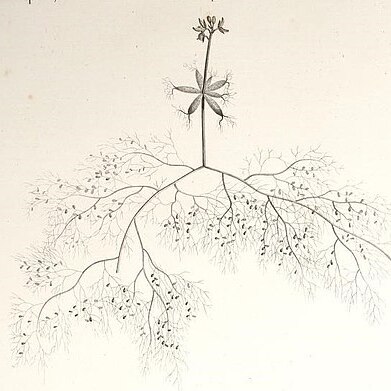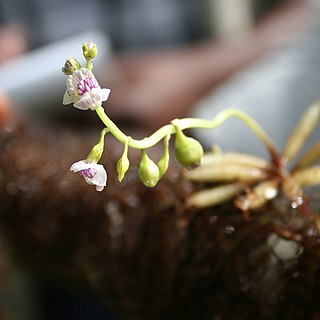Aquatic herb.. Stolons up to 1 m. long or more, terete, smooth and glabrous; internodes 3–10(–15) mm.. Leaves very numerous, digitately divided into 3–6 primary segments and usually auricled at the base; primary segments 2–6 cm. long, ± lanceolate in outline, pinnately divided, the rhachis filiform or ± inflated and up to 2 mm. thick; pinnae repeatedly dichotomously forked; ultimate segments capillary, minutely setulose; auricles when present reniform or orbicular, up to 10 mm. long, margin usually denticulate or ± divided into setulose capillary segments.. Floats verticillate or sub-verticillate on the lower half of the scape, 3–10, inflated, narrowly cylindrical to fusiform, 2–5 cm. long, bearing a variable number of reduced or sometimes well-developed leaf-segments at the apex.. Traps usually numerous, lateral near the base of the ultimate and penultimate leaf-segments, broadly ovoid, shortly stalked, 1–3 mm. long; mouth lateral; upper lip naked or with 2 short simple or sparsely branched hairs; lower lip naked or with a few shorter simple hairs.. Inflorescence erect, lateral, 3–20 cm. high; flowers 2–15, congested at anthesis; inflorescence-axis elongating in fruit; scape filiform to relatively stout, straight, smooth and glabrous; scales absent; bracts basifixed, ovate, 1–2 mm. long; bracteoles absent; pedicels filiform, erect or spreading at anthesis, 1.5–5 mm. long, strongly reflexed and thickened in fruit.. Calyx-lobes subequal, broadly ovate, apex rounded or lower sometimes emarginate, ± 3 mm. long at anthesis, strongly accrescent, becoming fleshy, up to 10 mm. long and enclosing the capsule.. Corolla white or yellow, usually variously marked with red or purple lines, 7–10 mm. long, ± densely covered externally with glandular hairs; upper lip broadly ovate, 1.5–2 times as long as the upper calyx-lobe, apex truncate or emarginate; lower lip orbicular, apex rounded or emarginate; palate raised, bigibbous; spur cylindrical, ± as long as the lower lip.. Filaments linear, dilated above; anther-thecae subdistinct.. Ovary globose, minutely squamulate; style distinct, as long as the ovary; stigma lower lip semi-orbicular, upper obsolete.. Capsule globose, circumscissile, ± 5 mm. in diameter with the style often considerably elongated.. Seeds numerous, prismatic, 4–6-angled, ± as wide as high, ± winged on the angles, hilum prominent; testa-cells distinct, elongated, ± 0.05 mm. long.
Leaves very numerous, digitately divided into 3–6 primary segments and usually auricled at the base; primary segments 2–6 cm. long, more or less lanceolate in outline, pinnately divided, the rhachis filiform or more or less inflated and up to 2 mm. thick; pinnae repeatedly dichotomously forked; ultimate segments capillary, minutely setulose; auricles when present reniform or circular, up to 10 mm. long, margin usually denticulate or more or less divided into setulose capillary segments.
Corolla white or yellow, usually variously marked with red or purple lines, 7–10 mm. long, more or less densely covered externally with glandular hairs; superior lip broadly ovate, 1.5–2 times as long as the upper calyx lobe, with apex truncate or emarginate; inferior lip circular, with apex rounded or emarginate; palate raised, bigibbous; spur cylindrical, more or less as long as the inferior lip; filaments linear, dilated above; anther-theacae subdistinct.
Inflorescence erect, lateral, 3–20 cm. high; flowers 2–15, congested at anthesis; inflorescence-axis elongating in fruit; peduncle filiform to relatively stout, straight, smooth and glabrous; scales absent; bracts basifixed, ovate, 1–2 mm. long; bracteoles absent; pedicels filiform, erect or spreading at anthesis, 1.5–5 mm. long, strongly and thickened in fruit.
Free-floating, submerged, aquatic annual or perennial to 1 m. Leaves finely dissected, fennel-like. Flowers in an ebracteolate, emergent raceme with a basal whorl of spongy floats, white, mauve or yellow, hairy outside, lips subequal, broadly ovate, notched, palate obscuring mouth, spur ± as long as lower lip. Fruits nodding.
Traps usually numerous, lateral near the base of the ultimate and penultimate leaf segments, broadly ovoid, shortly stalked, 1–3 mm. long; mouth lateral, naked or with 2 dorsal short simple or sparsely branched hairs, and sometimes with a few shorter ventral simple hairs.
Floats verticillate or subverticillate on the lower half of the peduncle, 3–10, inflated, narrowly cylindrical to fusiform, 2–5 cm. long, bearing a variable number of reduced or sometimes well developed leaf segments at the apex.
Calyx lobes subequal, broadly ovate, with apex rounded or lower sometimes emarginate, more or less 3 mm. long at anthesis, strongly acrescent, becoming fleshy, up to 10 mm. long and enclosing the capsule.
Seeds numerous, prismatic, 4–6 angled, more or less as wide as high, more or less winged on the angles, hilum prominent; testa-cells distinct, elongated, more or less 0.05 mm. long.
Ovary globose, minutely squamulate; style distinct, as long as the ovary; stigma inferior lip circular, superior obsolete.
Capsule globose, circumscissile, more or less 5 mm. in diam., with the style often considerably elongated.
Stolons up to 1 mm. long or more, terete, smooth and glabrous; internodes 3–10(15) mm.
Aquatic herb.


